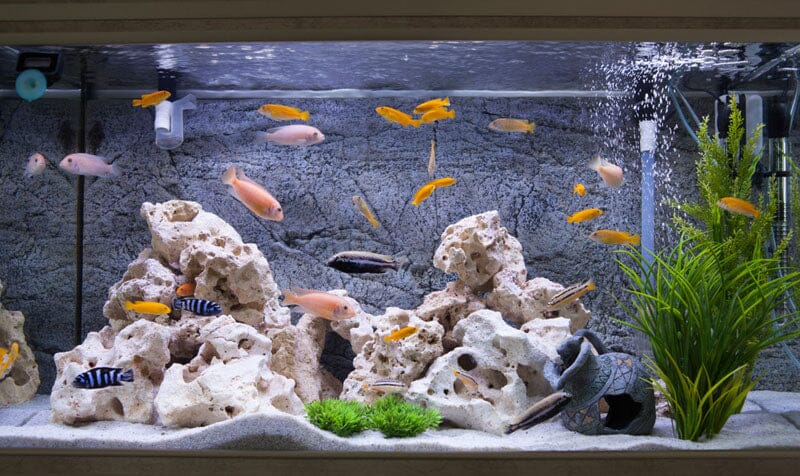Imagine owning a Picasso or a Van Gogh, but storing it in a musty attic filled with dirt and grime; it wouldn't matter how awe-inspiring the masterpiece is when its visible beauty is shrouded in filth. Now, equate that scenario to your vibrant aquarium - the lush marine life it harbors are your living works of art.
If you fail to maintain pristine conditions in their aquatic home, you end up putting these delicate creatures at risk and diminishing the aesthetic appeal of your aquarium. Choosing and using the right filter media for your aquarium is key in preserving the health of your aquatic ecosystem and showcasing its splendor.
Dive into our extensive guide to ensure you're making informed decisions when picking and utilizing the most suitable filter media for your aquarium's individual needs.
When choosing your filter media, consider the type of filtration you want to accomplish (mechanical, chemical, biological), match the media type to your filtration needs, and follow a proper order when placing them in your filter.
Regular maintenance of your filter media - such as rinsing or replacing them - will also ensure optimal performance. Our article on "How to Choose and Use the Right Filter Media" provides more detailed guidance on this topic.
The Different Types of Aquarium Filter Media
When it comes to aquarium filter media, there are three main types of filtration - biological, chemical, and mechanical. Each type of filtration has its own purpose and uses different types of media to accomplish the job.
Mechanical filtration is the process by which suspended or undissolved particulates are physically filtered out from the water. This type of filtration is important in keeping your water clear and free from debris. Some examples of mechanical filter media include filter wool or floss, bonded pads, or sponges.
Coarse mechanical filter media can be reused after rinsing and drying, whereas fine mechanical filter media is disposable and cannot be effectively rinsed clean. Regular maintenance is required for mechanical filters as the pads may need to be changed out quite often, usually every 3-5 days.
Chemical filtration removes dissolved contaminants that change the "chemical composition" of the water. By removing toxins and altering water chemistry, chemical filtration helps maintain a healthy environment for your fish.
Common types of chemical filter media include activated carbon, zeolite, peat, ferric hydroxide, and various resins. The right choice of chemical media depends on what you want to accomplish in terms of water quality.
Biological filtration harbors beneficial bacteria that help biologically break down waste via the nitrogen cycle. The bacteria convert dangerous ammonia into less harmful nitrites before finally converting them into nitrates that can be safely absorbed by aquatic plants or removed through water changes.
Biological filter media options include bio balls, ceramic rings or other porous materials that provide ample surface area for bacterial colonies to grow on.
Some owners prefer to use sponge material as both mechanical and biological media since sponges trap debris while also providing habitat for bacterial growth. While this practice saves money on separate filter units for each type of media, there is a risk of clogging up the sponge with debris and shutting down biological filtration.
With an understanding of the different types of aquarium filter media, we can now delve deeper into the specific purposes and benefits of biological media in maintaining a healthy aquatic environment.
- Maintaining a healthy aquatic environment requires different types of aquarium filter media, including mechanical filtration for removing physical debris, chemical filtration for removing dissolved toxins, and biological filtration for promoting beneficial bacteria growth. It is important to choose the appropriate type of media depending on desired water quality outcomes and to perform regular maintenance on mechanical filters. Sponge material can be used for both mechanical and biological functions but has the risk of clogging up with debris and limiting bacterial growth. Understanding the importance of each type of filter media is crucial in keeping fish healthy and water clear.
Biological Media
Biological filtration plays an important role in keeping your aquarium clean and healthy. The primary objective is to establish colonies of beneficial bacteria that help break down waste and remove toxins from the water column.

The most common type of biological filter media are ceramic rings or porous materials that provide ample surface area for bacterial colonies to grow on. Beneficial bacteria are aerobic, which means they require oxygen to process waste.
Ceramic rings have intricate pores that provide abundant surface area for beneficial bacteria to colonize while also allowing plenty of oxygen exchange through the material. While ceramic rings do not need frequent replacement, they still need to be cleaned at least once a year (or more often if needed) to avoid clogs.
Live plants also serve as an excellent means of biological filtration by consuming nitrates and other nutrients in the water. Aside from reducing nitrate levels, live plants also provide hiding places for shy fish species, create natural habitats, and enhance aesthetic appeal. Substrates such as sand or gravel provide additional surface area for beneficial bacteria growth while also holding beneficial chemicals that aid in plant growth.
Biological media in fish tank filtration systems can be compared to microbiomes in our digestive system. Just like good bacteria help keep our gut healthy by breaking down food and boosting immunity, beneficial bacteria in aquariums play an essential role in processing waste and supporting aquatic life.
Some hobbyists advocate for using live rock as biological filter media because it helps maintain pH levels and contains complex structures that support diverse microbial communities.
Others prefer bio balls or sponges because they are easier to maintain and do not require frequent cleaning. Ultimately, the choice of filter media will depend on your specific needs, preferences, and budget.
With an understanding of the benefits and options for biological filter media, we can now move on to discussing how to choose the right filter media for your aquarium.
- According to the American Pet Products Association, an estimated 10.5% of US households own a freshwater fish tank, emphasizing the need for effective aquarium filtration.
- Research conducted in 2017 suggested that mechanical filtration using fine mechanical media can remove up to 99.9% of particles larger than 0.5 mm from water in aquariums.
- A 2020 study cited that correct placement and maintenance of biological filter media could increase beneficial bacterial colonies by up to 70%, improving water quality significantly.
Chemical Media
When it comes to maintaining the chemistry of your aquarium water, you need chemical filter media to reduce the levels of dissolved contaminants. This not only helps keep your aquatic pets healthy but also crystal clear water which is aesthetically pleasing.
Chemical filter media works by adsorbing impurities through various chemical reactions, leaving clean water free from toxins and pollutants. The type of material you use for chemical filtration depends on the particular issue you want to address.
One example of a commonly used chemical filter medium is activated carbon, which is made up of highly porous charcoal material. Activated carbon scavenges both organic and inorganic matter and removes dissolved impurities such as chlorine present in tap water. Moreover, activated carbon can be used to eliminate medications or pollutants that could result in poor health for fish.
Zeolite filter media can effectively remove ammonia from the aquarium because it has an enormous surface area with pores. Ammonia waste created by fish can quickly become toxic so, zeolite acts as a natural buffer by buffering it out. However, zeolite must be rinsed and replaced frequently because once fully saturated it becomes ineffective.
Some types of chemical filter media raise the pH level, while others lower it. For instance, peat moss can be added for specific purposes; if you have acidic-water loving fish like tetras, catfish or discus, adding a bag or pouch will lead to a natural acidity rise. Therefore, If your fish require highly acidic water, then peat moss is the perfect choice for chemical filtration.
Now that we have gone through chemical filtration let's move onto mechanical filtration.

Mechanical Media
The benefit of mechanical filter media is that they are easy to maintain and don’t need consumable replacements as often as other filter mediums. Mechanical filters are great for catching large organic debris such as uneaten food, plant matter, and fish waste.
Coarse mechanical filter media such as sponges or filter wool work more efficiently than fine particles that cause clogging. You can reuse them multiple times by washing them when they become too dirty. However, you shouldn't wash these with soap or tap water because the soaps or chemicals in tap water can kill beneficial bacteria.
You can use bonded foam pads as mechanical media when it comes to deeper aquariums and greater water flow rates. They not only catch larger debris but allow for the growth of beneficial bacteria.
Using a mechanical filter is like using a strainer to sift flour- both work by removing impurities in large sizes. By placing a layer of mechanical filter media at the top of your filtration system, you achieve two things; you intercept impurities before they reach biological and chemical layers which increases their lifespan. Secondly, it maintains proper water flow throughout your filtration system.
We’ve now seen how chemical and mechanical filter media help maintain an optimal environment for aquatic life. Next up, let's discuss how to choose the right filter medium based on your specific needs.
How to Select the Right Filter Media
Choosing the right filter media for your aquarium can be a daunting task, but it's crucial in maintaining a healthy environment for your fish. Ultimately, your choice will depend on the type of filtration you need, the fish species you have, and even personal preference.
When selecting biological filter media, keep in mind that its primary function is to promote beneficial bacteria growth. Ceramic rings or porous bio balls are great options as they have a high surface area, which allows for more bacteria to grow. Sponge filters are also ideal for smaller tanks with low stocking densities.
Chemical filter media helps remove dissolved contaminants from the water, like chlorine and heavy metals. Activated carbon is often used in chemical filtration due to its effectiveness and affordability. Other options include zeolite and peat, which help reduce ammonia levels in the water.
Mechanical filter media is essential in removing larger particles from the water. Bonded filter pads or sponges can be an excellent choice here as they provide a large surface area and can trap debris well. Alternatively, filter socks can offer finer filtration by trapping tiny particles quickly.
When selecting the right filter media for your aquarium, it's important to consider all aspects of your tank's needs. Take into account any specific requirements for your fish species or plants and choose accordingly.
For example, if you have a heavily planted aquarium with delicate shrimp species, mechanical filtration isn't necessarily a priority as plants themselves can act as natural filters. In this case, investing in high-quality biological and chemical filtration would be essential in maintaining a healthy ecosystem.
It's also important to note that cheaper isn't always better when it comes to aquarium filter media. While marketplaces may offer bargain deals on generic filter pads or ceramic rings, investing in higher-quality media can provide more effective results and prevent replacing them frequently.
Some aquarium hobbyists argue that adding chemical filter media isn't necessary at all, stating that proper maintenance and consistent water changes suffice. However, others maintain that chemical filtration is crucial in maintaining the right water chemistry for their aquariums. Ultimately, the decision to include chemical media is personal preference based on one's individual experience.
Proper Use and Maintenance of Filter Media
Proper use and maintenance of your filter media can contribute significantly to its longevity, effectiveness, and efficiency in keeping your aquarium healthy.
Mechanical filtration needs to be cleaned frequently. Keeping pads or sponges clean can prevent clogging and ensure water flow remains steady. Coarse sponge filters can be rinsed and reused several times before disposal, while finer media pads may need replacing as soon as they become too dirty.
Biological filter media should never be fully replaced. Doing so will disrupt colonies of beneficial bacteria within the filter system, leading to a disruption in the nitrogen cycle. Gently rinsing ceramic rings or bio balls in some old tank water every few months will help remove built-up debris without removing the bacteria entirely.
Chemical filters typically have a limited lifespan, which means they'll need replacement more often than mechanical filtration or biological filtration. Activated carbon can last approximately four weeks before requiring replacement, while other kinds of chemical media may have different longevity periods.
For example, if you notice your water appearing yellowish or greenish despite regular cleaning and maintenance, it's an indication that your chemical filter is no longer doing its job effectively. In this case, consider changing out or replacing the media per the manufacturer's recommendations.
Think of filter media like any other aquarium accessory - it requires regular upkeep to function as intended. Suppose you neglect routine maintenance for an extended period. In that case, you risk disrupting your aquatic ecosystem's balance and potentially endangering your fish species.
Proper maintenance of your filter media will ensure a healthy and thriving aquatic environment in your aquarium. In the next section, we'll cover when and how to replace your filter media to keep things running smoothly.
When and How to Replace Filter Media
One of the common mistakes that aquarium enthusiasts make is to overlook the maintenance of filter media. Some aquarists believe that they do not need to replace the filter media as long as it appears to be functioning normally. However, this can result in a buildup of debris, clogged media, and bacterial die-off, which can ultimately lead to poor water quality and sick or stressed fish.
To avoid such problems, it is crucial to follow a regular schedule for replacing filter media. For mechanical filters, it's recommended to clean or replace the media every 7-14 days depending on your tank size and population. While coarse mechanical filters like sponges can be reused after rinsing and drying them out in the sun, finer types need to be disposed of after use.
Chemical filtration media like activated charcoal has a lifespan of around 4-6 weeks before losing its effectiveness in removing contaminants from the water. There are ways to tell when chemical media has reached its limit; some of the signs include an increase in nitrate or phosphate levels, yellowing in water clarity, or an odor coming from the aquarium. It's essential to replace chemical filter media before these signals appear.
Although there are many claims that using old filter media can help speed up colonization of bacteria in new tanks, this could prove harmful over time as dying bacteria may compromise the balance of nitrates in your tank by releasing ammonia.
Think of your car's oil filter – if you do not change it regularly, oil will get dirty fast and cause irreparable damage to your engine. The same scenario applies to your aquarium's filter media if you don't replace it timely.
By replacing the filter media whenever necessary, you'll be providing your fish with a healthy and safe environment to live in. The extent of the regularity with which filter media needs replacing depends on tank size, population, and what kind of filter media is employed, but it's always good to have clear release schedules to ensure that your tank continues to thrive.
Overall, maintaining a healthy living environment for your aquarium’s inhabitants requires proper selection, placement, and maintenance of appropriate filter media. Regularly replacing spent types ensures water is free of debris and pollutants while also supporting bacterial growth. A clean and healthy tank means happy and healthy fish!




